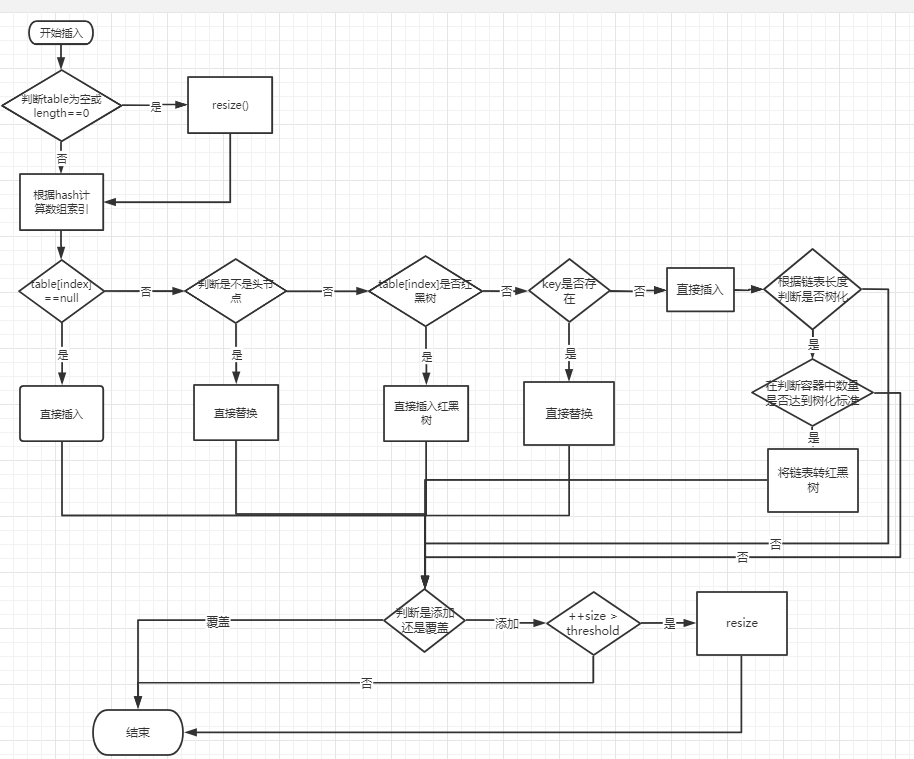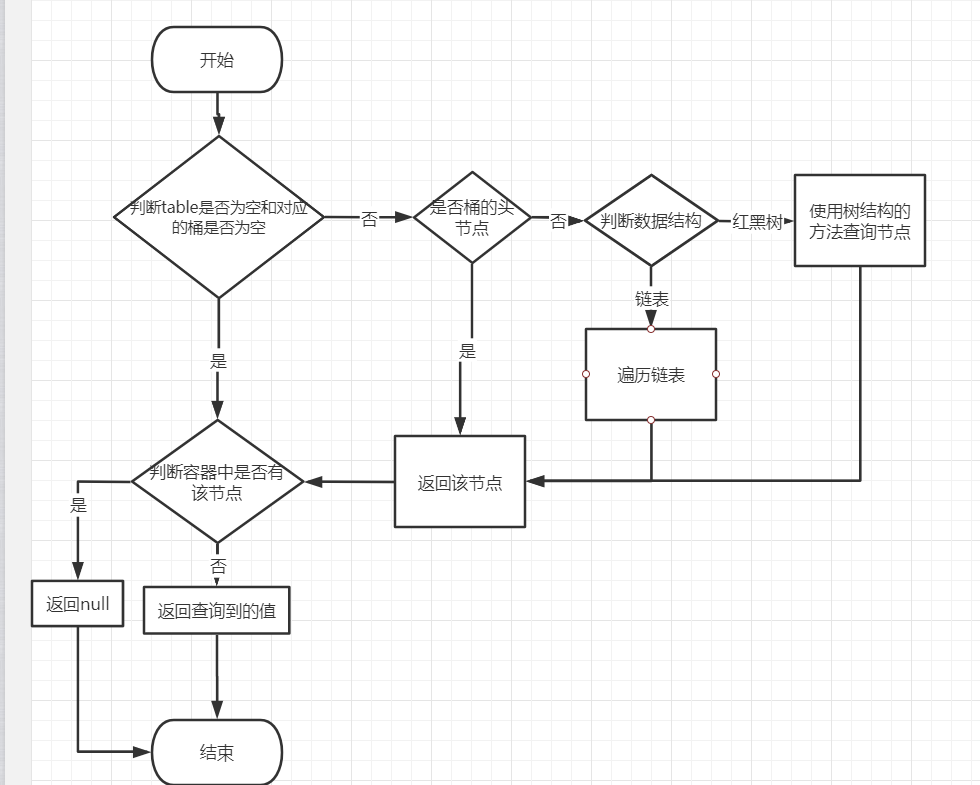前言
正文
本文用jdk版本:1.8.0_181 和1.7
1.8版本
构造方法
// 无参构造方法
public HashMap() {
this.loadFactor = DEFAULT_LOAD_FACTOR; // all other fields defaulted
}
// 指定容器初始化数组容量
public HashMap(int initialCapacity) {
this(initialCapacity, DEFAULT_LOAD_FACTOR);
}
// 指定容器的初始化数组的容量
public HashMap(int initialCapacity, float loadFactor) {
if (initialCapacity < 0)
throw new IllegalArgumentException("Illegal initial capacity: " +
initialCapacity);
if (initialCapacity > MAXIMUM_CAPACITY)
initialCapacity = MAXIMUM_CAPACITY;
if (loadFactor <= 0 || Float.isNaN(loadFactor))
throw new IllegalArgumentException("Illegal load factor: " +
loadFactor);
this.loadFactor = loadFactor;
// 将传入的值赋予经过tableSizeFor后赋值给threshold;
this.threshold = tableSizeFor(initialCapacity);
}
注意:
- 这里并没有一开始就初始化容器中的数组,只是将传入的数量赋值给threshold;
- 还需要注意的是tableSizeFor这个方法,这个方法会自动将传入的值改变为一个为2整数次幂的一个整数;
添加方法
public V put(K key, V value) {
return putVal(hash(key), key, value, false, true);
}
注意:
- 注意这里的hash方法,key为null会返回0,HashMap可以存null 的key就是在这里体现的;
第二个方法:
final V putVal(int hash, K key, V value, boolean onlyIfAbsent,boolean evict) {
Node<K,V>[] tab; Node<K,V> p; int n, i;
// 判断当前容器数组是否已经初始化
if ((tab = table) == null || (n = tab.length) == 0)
// 这里是初始化容器数组
n = (tab = resize()).length;
// 判断数组对应索引位置是否有数据,无则直接将存入的数作为链头放入数组
if ((p = tab[i = (n - 1) & hash]) == null)
tab[i] = newNode(hash, key, value, null);
else {
Node<K,V> e; K k;
// 判断存入对象是否与该位置链表的头节点一致
if (p.hash == hash &&((k = p.key) == key || (key != null && key.equals(k))))
e = p;
// 判断对象存入对应位置的数据结构是否为红黑树
else if (p instanceof TreeNode)
// 存入红黑树
e = ((TreeNode<K,V>)p).putTreeVal(this, tab, hash, key, value);
else {
// 循环对应位子的链表
for (int binCount = 0; ; ++binCount) {
if ((e = p.next) == null) {
// 链表末尾添加该节点
p.next = newNode(hash, key, value, null);
// 判断是否要将链表转红黑树
if (binCount >= TREEIFY_THRESHOLD - 1) // -1 for 1st
// 将链表转红黑树
treeifyBin(tab, hash);
break;
}
// 判断链表中是否存在该对象,存在则替换
if (e.hash == hash &&
((k = e.key) == key || (key != null && key.equals(k))))
break;
p = e;
}
}
// 判断链表中是否存在存入的对象
if (e != null) { // existing mapping for key
V oldValue = e.value;
if (!onlyIfAbsent || oldValue == null)
e.value = value;
afterNodeAccess(e);
// 返回原来的值
return oldValue;
}
}
++modCount;
// 判断存入对象后是否达到扩容标准
if (++size > threshold)
// 这里是扩容
resize();
afterNodeInsertion(evict);
return null;
}
注意:
- 注意resize方法,该方法实现将容器真正的初始化和扩容
- 容器中的红黑树是用TreeNode实现的
- 这里的链表插入是插入末尾
- 判断是否将链表转为红黑树是根据TREEIFY_THRESHOLD这个属性来判断的,转换调用的方法是treeifyBin
- afterNodeAccess和afterNodeInsertion这两个方法是LinkedHashMap实现的,需要去了解LinkedHashMap;因为存入对象在容器中存在,所以会调用afterNodeAccess方法,将存入的对象对应的节点排到最后,表示刚使用过;因为存入的对象在容器中不存在,所以是加入了一个节点,所以调用afterNodeInsertion方法,会去掉LinkedHashMap中的头节点;
resize方法
该方法主要是初始化或扩容的
final Node<K,V>[] resize() {
Node<K,V>[] oldTab = table;
int oldCap = (oldTab == null) ? 0 : oldTab.length;
int oldThr = threshold;
int newCap, newThr = 0;
// 判断是否扩容
if (oldCap > 0) {
// 判断数组是否达到最大值
if (oldCap >= MAXIMUM_CAPACITY) {
threshold = Integer.MAX_VALUE;
return oldTab;
}
// 扩容一倍,变为原来两倍
else if ((newCap = oldCap << 1) < MAXIMUM_CAPACITY &&
oldCap >= DEFAULT_INITIAL_CAPACITY)
newThr = oldThr << 1; // double threshold
}
// 判断是否在构造时是否指定了容量
else if (oldThr > 0) // initial capacity was placed in threshold
newCap = oldThr;
else { // zero initial threshold signifies using defaults
// 没指定就使用默认值,数组初始化长度为DEFAULT_INITIAL_CAPACITY16
newCap = DEFAULT_INITIAL_CAPACITY;
// 将容器扩容标准设置为默认值(初始化长度*加载因子;就是数组长度的3/4)
newThr = (int)(DEFAULT_LOAD_FACTOR * DEFAULT_INITIAL_CAPACITY);
}
// 如果构造容器时指定了容量,则会将扩容标准设置为指定值的3/4
if (newThr == 0) {
float ft = (float)newCap * loadFactor;
newThr = (newCap < MAXIMUM_CAPACITY && ft < (float)MAXIMUM_CAPACITY ?
(int)ft : Integer.MAX_VALUE);
}
threshold = newThr;
@SuppressWarnings({"rawtypes","unchecked"})
// 构造扩容后的新数组
Node<K,V>[] newTab = (Node<K,V>[])new Node[newCap];
table = newTab;
// 判断原来的数组中是否有数据
if (oldTab != null) {
// 循环原来数组中的每个节点
for (int j = 0; j < oldCap; ++j) {
Node<K,V> e;
// 判断空
if ((e = oldTab[j]) != null) {
oldTab[j] = null;
// 如果该节点只有一个对象,则直接放入新的数组中对应的位置
if (e.next == null)
newTab[e.hash & (newCap - 1)] = e;
// 判断该节点是否为红黑树
else if (e instanceof TreeNode)
// 将红黑树拆分,并放入新的数组中
((TreeNode<K,V>)e).split(this, newTab, j, oldCap);
else { // preserve order
Node<K,V> loHead = null, loTail = null;
Node<K,V> hiHead = null, hiTail = null;
Node<K,V> next;
// 将该节点的链表拆分,拆分后只会放入新的数组中的两个节点中
do {
next = e.next;
if ((e.hash & oldCap) == 0) {
if (loTail == null)
loHead = e;
else
loTail.next = e;
loTail = e;
}
else {
if (hiTail == null)
hiHead = e;
else
hiTail.next = e;
hiTail = e;
}
} while ((e = next) != null);
if (loTail != null) {
loTail.next = null;
newTab[j] = loHead;
}
if (hiTail != null) {
hiTail.next = null;
newTab[j + oldCap] = hiHead;
}
}
}
}
}
return newTab;
}
注意:
- 原来数组中的数据放到新数组中,只会存在两个节点中;
- 扩容是变为原来的两倍,是数组长度扩容
treeifyBin 方法
final void treeifyBin(Node<K,V>[] tab, int hash) {
int n, index; Node<K,V> e;
// 判断数组长度是否达到树化的标准MIN_TREEIFY_CAPACITY=64
if (tab == null || (n = tab.length) < MIN_TREEIFY_CAPACITY)
resize();
// 遍历链表,将其转换为树,注意并不是红黑树
else if ((e = tab[index = (n - 1) & hash]) != null) {
TreeNode<K,V> hd = null, tl = null;
do {
TreeNode<K,V> p = replacementTreeNode(e, null);
if (tl == null)
hd = p;
else {
p.prev = tl;
tl.next = p;
}
tl = p;
} while ((e = e.next) != null);
if ((tab[index] = hd) != null)
// 这里转换红黑树
hd.treeify(tab);
}
}
注意:
- 链表转红黑树并不是链表长度达到8之后就可以,而是还需要数组长度也达到64以上
get方法
public V get(Object key) {
Node<K,V> e;
// 判断容器中是否有该节点,有返回value,无则返回null
return (e = getNode(hash(key), key)) == null ? null : e.value;
}
getNode方法
final Node<K,V> getNode(int hash, Object key) {
Node<K,V>[] tab; Node<K,V> first, e; int n; K k;
// 判断数组长度以及对应索引的桶是否也为空
if ((tab = table) != null && (n = tab.length) > 0 &&
(first = tab[(n - 1) & hash]) != null) {
// 判断是否桶中第一个节点
if (first.hash == hash && // always check first node
((k = first.key) == key || (key != null && key.equals(k))))
return first;
// 判断是否还有下一个节点
if ((e = first.next) != null) {
// 判断是否为树
if (first instanceof TreeNode)
// 按树的结构来查找
return ((TreeNode<K,V>)first).getTreeNode(hash, key);
do {// 遍历链表查找
if (e.hash == hash &&
((k = e.key) == key || (key != null && key.equals(k))))
return e;
} while ((e = e.next) != null);
}
}
return null;
}
put流程图

get流程图

1.7与 1.8比较
-
数据结构
1.7使用数组加链表的数据结构,1.8使用数组,链表加红黑树的数据结构 -
初始化以及扩容
1.7使用 -
数据插入方式
1.7使用头插法,将数据插入头节点;1.8使用尾插法,将数据插入链表末尾,即便是扩容也是尾插法 -
hash计算方式
1.8使用了一次位运算加一次异或运算;1.7进行了四次位运算加五次异或运算;